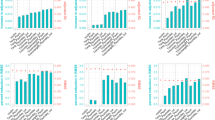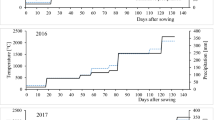Abstract
Growth in population, decrease in arable land area, and change in climate are endangering our food security. Precision agriculture has the potential to increase crop productivity thorough tailored agricultural practices for different growing areas. Many models of crops and agro-ecosystems capable of predicting interaction between plants and environments have been developed for precision agriculture. Currently, there are several representative categories of crop and agro-ecosystem models, including the de Wit school models, the DSSAT series models and the APSIM series models, which have contributed substantially to improvement of agricultural practices. However, these models are weak in predicting performances of crops under environmental and genetic perturbations are generally weak, which severely limits the application of these models in guiding precision agriculture. We need to develop the next generation crop and agro-ecosystems models with a high level of mechanistic basis, which can be integrated with high throughput data and can predict the heterogeneity of environmental factors inside canopy and dynamic canopy photosynthesis. In developing such a model close collaboration is inevitably required among scientists from different disciplines. The successful development and application of such models will undoubtedly advance precision agriculture through providing better agronomical practices tailored for different growing environments. These models will also form a basis to identify breeding targets for increased productivity at given location with given soil and climatic conditions.
Similar content being viewed by others
References
Conway G, Toenniessen G. Feeding the world in the twenty-first century. Nature, 1999, 402: C55–C58
Peng S B, Tang Q, Zou Y. Current status and challenges of rice production in China. Plant Prod Sci, 2009, 12: 3–8
Stafford J V. Implementing precision agriculture in the 21st century. J Agr Eng Res, 2002, 76: 267–275
Niinemets U L O. Photosynthesis and resource distribution through plant canopies. Plant Cell Environ, 2007, 30: 1052–1071
Zhu X G, Long S P, Ort D R. Improving photosynthetic efficiency for greater yield. Ann Rev Plant Biol, 2010, 61: 235–261
Sage R F, Kubien D S. The temperature response of C3 and C4 photosynthesis. Plant Cell Environ, 2007, 30: 1086–1106
Atkin O K, Macherel D. The crucial role of plant mitochondria in orchestrating drought tolerance. Ann Bot, 2009, 103: 581–597
Cornic G, Fresneau C. Photosynthetic carbon reduction and carbon oxidation cycles are the main electron sinks for photosystem II activity during a mild drought. Ann Bot, 2002, 89: 887–894
Long S P, Humphries S W, Falkowski P G. Photoinhibition of photosynthesis in nature. Ann Rev Plant Physiol Plant Mol Biol, 1994, 45: 633–662
Slafer G A. Genetic basis of yield as viewed from a crop physiologist’s perspective. Ann Appl Biol, 2003, 142: 117–128
Murchie E H, Pinto M, Horton P. Agriculture and the new challenges for photosynthesis research. New Phytol, 2008, 181: 532–552
Gibson S. Control of plant development and gene expression by sugar signaling. Cur Opin Plant Sci, 2005, 8: 93–102
Zhu X G, Long S P, Ort D R. What is the maximum efficiency with which photosynthesis can convert solar energy into biomass? Current Opin Biotech, 2008, 19: 153–159
Cramer W A, Zhang H M, Yan J S, et al. Transmembrane traffic in the cytochrome b6f complex. Ann Rev Biochem, 2006, 75: 769–790
Nelson N, Yocum C F. Structure and function of photosystems I and II. Ann Rev Plant Biol, 2006, 57: 521–565
Raines C A. The calvin cycle revisited. Photosyn Res, 2003, 75: 1–10
Lawlor D W, Tezara W. Causes of decreased photosynthetic rate and metabolic capacity in water-deficient leaf cells: a critical evaluation of mechanisms and integration of processes. Ann Bot, 2009, 103: 561–579
Zhu X G, De Sturler E, Long S P. Optimizing the distribution of resources between enzymes of carbon metabolism can dramatically increase photosynthetic rate: A numerical simulation using an evolutionary algorithm. Plant Physiol, 2007, 145: 513–526
Rogers A, Humphries S W. A mechanistic evaluation of photosynthetic acclimation at elevated CO2. Glob Change Biol, 2000, 6: 1005–1011
Lin Z H, Mo X G, Xiang Y Q. Research advances on crop growth models. Acta Agron Sin, 2003, 29: 750–758
Jones J W, Hoogenboom G, Porter C H, et al. The DSSAT cropping system model. Europ J Agron, 2003, 18: 235–265
Bouman B A M, Van Keulen H, Van Laar H H, et al. The ’school of de Wit’ crop growth simulation models: a pedigree and historical overview. Agri Syst, 1996, 52: 171–198
de Wit C T, Penning de Vries F W T. The simulation of photosynthetic systems. In: Prediction and Management of Photosynthetic Productivity, Proceedings of the International Biological Program/Plant Production Technical Meeting. Wageningen, 1970. 47–70
de Wit C T. Simulation of assimilation, respiration and transpiration of crops. Simul Monographs, 1978
Penning de Vries F W T, Laar H H. Simulation of plant growth and crop production. In: PUDOC, Wageningen, 1982, 1–308
Van Keulen H, Penning de Vries F W T, Drees E M. A summary model for crop growth. In: Penning de Vries F W T, van Laar H H, eds. Simulation of Plant Growth and Crop Production. Simulation Monograph, PUDOC, Wageningen, 1982. 87–98
Keulen H, Wolf J. Modelling of agricultural production: weather, soils and crops. In: PUDOC, Wageningen, 1986, 1–478
Penning de Vries F W T, Jansen D M, M. Ten Berge H F M, et al. Simulation of ecophysiological processes of growth in several annual crops. In: Simulation Monograph, PUDOC, Wageningen, 1989. 1–280
Spitters C J T, Schapendonk A. Evaluation of breeding strategies for drought tolerance in potato by means of crop growth simulation. Plant Soil, 1990, 123: 193–203
Lal H, Hoogenboom G, Calixte J P, et al. Using crop simulation modles and GIS for regional productivity analysis. Trans ASABE, 1993, 36: 175–184
Mccown R L, Hammer G L, Hargreaves J N G, et al. APSIM: a novel software system for model development, model testing and simulation in agricultural systems research. Agr Syst, 1996, 50: 255–271
Parton W J, Stewart J W B, Cole C V. Dynamics of C, N, P and S in grassland soils: a model. Biogeochemistry, 1988, 5: 109–131
Humphries S W, Long S P. WIMOVAC: a software package for modelling the dynamics of plant leaf and canopy photosynthesis. Comput Appl Biosci, 1995, 11: 361–371
Farquhar G D, Von Caemmerer S, Berry J A. A biochemical model of photosynthetic CO2 assimilation in leaves of C3 species. Planta, 1980, 149: 78–90
Lawlor D W, Cornic G. Photosynthetic carbon assimilation and associated metabolism in relation to water deficits in higher plants. Plant Cell Environ, 2002, 25: 275–294
Stitt M, Krapp A. The interaction between elevated carbon dioxide and nitrogen nutrition: the physiological and molecular background. Plant Cell Environ, 1999, 22: 583–621
Buckley T N, Mott K A, Farquhar G D. A hydromechanical and biochemical model of stomatal conductance. Plant Cell Environ, 2003, 26: 1767–1785
Morgan J A, Rhodes D. Mathematical modeling of plant metabolic pathways. Metabol Eng, 2002, 4: 80–89
Rolland F, Baena-Gonzalez E, Sheen J. Sugar sensing and signaling in plants: conserved and novel mechanisms. Ann Rev Plant Biol, 2006, 57: 675–709
Rolland F, Moore B, Sheen J. Sugar sensing and signaling in plants. Plant Cell, 2002, 14: S185–205
Rolland F, Sheen J. Sugar sensing and signalling networks in plants. Biochem Soc Trans, 2005, 33: 269–271
Stitt M, Muller C, Matt P, et al. Steps towards an integrated view of nitrogen metabolism. J Exp Bot, 2002, 53: 959–970
Scheible W R, Lauerer M, Schulze E D, et al. Accumulation of nitrate in the shoot acts as a signal to regulate shoot-root allocation in tobacco. Plant J, 1997, 11: 671–691
Yin X Y, Struik P C, Van Eeuwijk F A, et al. QTL analysis and QTL-based prediction of flowering phenology in recombinant inbred lines of barley. J Exp Bot, 2005, 56: 967–976
Tsukaya H. Mechanisms of leaf shape determination. Ann Rev Plant Biol, 2006, 57: 477–496
Yin X Y, Struik P C, Tang J J, et al. Model analysis of flowering phenology in recombinant inbred lines of barley. J Exp Bot, 2005, 56: 959–965
Yin X Y, Struik P C, Kropff M J. Role of crop physiology in predicting gene-to-phenotype relationships. Trends Plant Sci, 2004, 9: 426–432
Yin X Y, Al E. Coupling estimated effects of QTLs for physiological traits to a crop growth model: predicting yield variation among recombinant inbred lines in barley. Heredity, 2000, 85: 539–549
Bailey T L, Elkan C. Unsupervised learning of multiple motifs in biopolymers using expectation maximization. Mach Learn, 1995, 21: 51–80
Lawrence C E, Altschul S F, Boguski M S, et al. Detecting subtle sequence signals-A Gibbs sampling strategy for multiple alignment. Science, 1993, 262: 208–214
Siddharthan R, Siggia E D, Van Nimwegen E. PhyloGibbs: A Gibbs sampling motif finder that incorporates phylogeny. Plos Comput Biol, 2005, 1: 534–556
Friedman N, Linial M, Nachman I, et al. Using Bayesian networks to analyze expression data. J Comput Biol, 2000, 7: 601–620
Segal E, Yelensky R, Koller D. Genome-wide discovery of transcriptional modules from DNA sequence and gene expression. Bioinformatics, 2003, 19Suppl.: i273–i282
Segal E, Shapira M, Regev A, et al. Module networks: identifying regulatory modules and their condition-specific regulators from gene expression data. Nat Genet, 2003, 34: 166–176
Lee T I, Rinaldi N J, Robert F, et al. Transcriptional regulatory networks in Saccharomyces cerevisiae. Science, 2002, 298: 799–804
Bar-Joseph Z, Gerber G K, Lee T I, et al. Computational discovery of gene modules and regulatory networks. Nat Biotech, 2003, 21: 1337–1342
Harbison C T, Gordon D B, Lee T I, et al. Transcriptional regulatory code of a eukaryotic genome. Nature, 2004, 431: 99–104
Jin V X, Rabinovich A, Squazzo S L, et al. A computational genomics approach to identify cis-regulatory modules from chromatin immunoprecipitation microarray data-A case study using E2F1. Genome Res, 2006, 16: 1585–1595
Niinemets U, Valladares F. Photosynthetic acclimation to simultaneous and interacting environmental stresses along natural light gradients: Optimality and constraints. Plant Biol, 2004, 6: 254–268
Long S P, Zhu X G, Naidu S L, et al. Can improvement in photosynthesis increase crop yields? Plant Cell Environ, 2006, 29: 315–330
Leakey A D B, Scholes J D, Press M C. Physiological and ecological significance of sunflecks for dipterocarp seedlings. J Exp Bot, 2005, 56: 469–482
Pearcy R W, Roden J S, Gamon J A. Sunfleck dynamics in relation to canopy structure in a soybean (Glycine max (L.) Merr) canopy. Agr Forest Meteorol, 1990, 52: 359–372
Pearcy R W, Yang W M. A three-dimensional crown architecture model for assessment of light capture and carbon gain by understory plants. Oecologia, 1996, 108: 1–12
Espana M L, Baret F, Aries F, et al. Modeling maize canopy 3D architecture-Application to reflectance simulation. Ecol Model, 1999, 122: 25–43
Fischer R A. Understanding the physiological basis of yield potential in wheat. J Agr Sci, 2007, 145: 99–113
Reynolds M, Calderini D, Condon A, et al. Association of source/sink traits with yield, biomass and radiation use efficiency among random sister lines from three wheat crosses in a high-yield environment. J Agr Sci, 2007, 145: 3–16
Martha G J, Kay D, Alan M M. Starch synthesis in t he cereal endosperm. Curr Opin Plant Biol, 2003, 6: 215–222
Geigenberger P, Stitt M, Fernie A R. Metabolic control analysis and regulation of the conversion of sucrose to starch in growing potato tubers. Plant Cell Environ, 2004, 27: 655–673
Clifford P E, Offler C E, Patrick J W. Growth-regulators have rapid effects on photosynthate unloading from seed coats of phaseolus-vulgaris L. Plant Physiol, 1986, 80: 635–637
Jones R J, Brenner M L. Distribution of abscisic-acid in maize kernel during grain filling. Plant Physiol, 1987, 83: 905–909
Jang J C, Leon P, Zhou L, et al. Hexokinase as a sugar sensor in higher plants. Plant Cell, 1997, 9: 5–19
Sheen J. Feedback control of gene expression. Photosynth Res, 1994, 39: 427–438
Author information
Authors and Affiliations
Corresponding author
Rights and permissions
About this article
Cite this article
Zhu, X., Zhang, G., Tholen, D. et al. The next generation models for crops and agro-ecosystems. Sci. China Inf. Sci. 54, 589–597 (2011). https://doi.org/10.1007/s11432-011-4197-8
Received:
Accepted:
Published:
Issue Date:
DOI: https://doi.org/10.1007/s11432-011-4197-8




